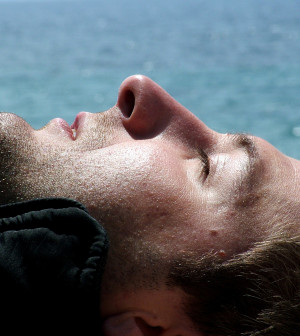- Navigating Your Midlife Crisis: Embracing New Possibilities
- City Raccoons Showing Signs of Domestication
- Mapping the Exposome: Science Broadens Focus to Environmental Disease Triggers
- One Week Less on Social Media Linked to Better Mental Health
- Your Brain Changes in Stages as You Age, Study Finds
- Some Suicide Victims Show No Typical Warning Signs, Study Finds
- ByHeart Formula Faces Lawsuits After Babies Sickened With Botulism
- Switch to Vegan Diet Could Cut Your Greenhouse Gas Emissions in Half
- Regular Bedtime Does Wonders for Blood Pressure
- Dining Alone Could Mean Worse Nutrition for Seniors
PTSD May Affect Boys, Girls Differently, Brain Scans Show

Post-traumatic stress disorder (PTSD) affects the brains of girls and boys in different ways, a new study suggests.
Researchers used MRI scans to examine the brains of 59 children, aged 9 to 17. The participants included 30 kids with PTSD and 29 without the disorder (the “control” group).
Girls and boys in the control group had no differences in brain structure, the researchers said. But among those with PTSD, girls and boys showed differences in one part of the insula — an area of the brain involved in emotion and empathy.
This brain area was larger in boys with PTSD than in other boys, and was smaller in girls with PTSD than in the control group girls, according to researchers from the Stanford University School of Medicine in California.
The findings, published online Nov. 11 in the journal Depression and Anxiety, are believed to be the first of their kind, the study authors noted in a university news release.
“The insula appears to play a key role in the development of PTSD,” said senior author Dr. Victor Carrion, a professor of psychiatry and behavioral sciences at Stanford.
“The difference we saw between the brains of boys and girls who have experienced psychological trauma is important because it may help explain differences in trauma symptoms between sexes,” he added.
Previous studies have found that girls are more likely than boys to develop PTSD after undergoing traumatic stress. The symptoms include: flashbacks; withdrawal from people, places and things that call the trauma to mind; and problems sleeping and concentrating.
Study author Megan Klabunde is an instructor of psychiatry and behavioral sciences. “It is important that people who work with traumatized youth consider the sex differences,” she said.
“Our findings suggest it is possible that boys and girls could exhibit different trauma symptoms, and that they might benefit from different approaches to treatment,” Klabunde explained in the news release.
More information
The U.S. National Center for PTSD has more on how the disorder affects children and teens.
Source: HealthDay
Copyright © 2025 HealthDay. All rights reserved.










